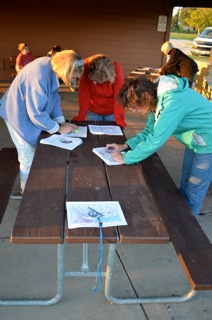In the end we will conserve only what we love. We will love only what we understand. We will only understand what we are taught.
—Baba Dioum
Our mission is to provide schools and community members of all ages with activities that help all visitors understand the interaction of natural and human forces in the Pheasant Branch Watershed.
A variety of programs have been developed to accomplish this mission…
For Schools
- Field trips for school aged children
For Community Members
- Conservancy Days - monthly speaker series for all ages
- Engage with Nature - Virtual activities for everyone
- Engage with Nature - Citizen Science opportunities
EDUCATION PROGRAM NEWS

Photo: Paul Ludden By Peter Witucki, Friends of Pheasant Branch Conservancy Board Member Across its 700 acres, Pheasant Branch Conservancy (PBC) protects important habitats, including restored oak savanna and prairies as well as a spring and wetland complex feeding into Lake Mendota. The Conservancy is home to rare and threatened animals, and an important rest stop for migrating birds. Pheasant Branch Conservancy is also a place where many people find peace and solace in nature close to the heart of downtown Middleton. In 2022, the Conservancy was recognized as Madison Magazine’s “Best Running/Biking Trail.” With all these different functions, this raises important questions about how–and for whom–Pheasant Branch Conservancy should be managed. As we explore this idea, ask yourself: What exactly is a conservancy, and how is it different from a park? Both are public lands appreciated by visitors, but how are the management priorities different? Are there activities enjoyed in parks that would feel inappropriate in a conservancy? How do land managers balance the protection of wildlife with the importance of exposing visitors to the wonders of natural areas? Pheasant Branch Conservancy is a complex of protected areas managed by Dane County Parks and the City of Middleton (technically, the Wisconsin Department of Natural Resources owns parcels as well). This complicates the question of ‘What is a conservancy?’. Fortunately, all the land managers have complementary management frameworks. Middleton Parks defines conservancy lands as: “natural areas managed for natural vegetation, habitat, water quality, and passive recreation. Trails provide access into and around conservancies, and facilities are generally limited to benches and waysides.” Similarly, Dane County Parks considers natural resource areas like Pheasant Branch as: “lands designated for the protection of a valuable natural environment, wildlife habitat, open space, and/or greenbelt corridor. Recreation at Natural Resource Areas is a secondary objective, with limited to no developed facilities–users are encouraged to enjoy the resource as is.” In both cases, the land managers identify recreational access as a goal, but secondary to the protection of the natural resource. Thinking about these questions helps us to recognize the multiple roles the Conservancy serves in our community and the need for continued protection of this special place. It also helps us better understand the conflicts that can arise from trying to balance multiple management goals and passionate constituencies! In the past, the Friends of Pheasant Branch Conservancy has attempted to mediate debates over accessibility and use, and some examples can be illustrative: Dogs For those of us who have had dogs in our lives, we know there is no bigger motivation to get outside and move than a dog eager for their exercise! But dogs–and particularly off-leash dogs–can be intimidating to other visitors and negatively impact protected wildlife. PBC has a permissive dog policy compared to comparable properties; PBC allows leashed dogs on most trails and asks users to avoid ground nesting bird habitat during nesting season. By comparison, City of Madison Conservation Parks and the UW Arboretum strictly prohibit dogs. To maintain the current policy, the Friends urge visitors with dogs to responsibly follow the guidelines. Bikes Bicycles are permitted on paved and crushed limestone paths and prohibited on grass and dirt trails. This opens large areas of the Conservancy to access by bicycle while maintaining sensitive habitat, hiking trails, and fragile trail surface from disturbance. The Conservancy’s bicycle policy is also permissive compared to other properties. City of Madison Conservation Parks prohibit bicycles. The UW Arboretum restricts bicycles to roadways only. The UW Lakeshore Preserve limits bikes to the main multiuse path, having removed bicycle access to Picnic Point trails. Cyclists are urged to only use the bicycle routes in PBC and to be cognizant of the many other Conservancy users sharing the path. E-mobility Dane County Parks and the City of Middleton do not have policies restricting the use of e-bikes, e-scooters, one-wheels, and other electric mobility devices, but this is a topic of concern among land managers and municipalities everywhere. These devices can make experiencing PBC more accessible to folks with mobility challenges, but irresponsible use is dangerous and disruptive. E-mobility users should follow the land managers’ bicycle guidance, remembering that some of these vehicles are faster and heavier than traditional bicycles, posing an increased risk. Paved vs. Natural surface trails Accessibility advocates and some cyclists have argued for paving some or all the paths in the Conservancy to afford access to visitors with limited mobility and to expand bicycle commuting options in the region. This has been a contentious issue over many years and merits a much longer discussion. For the purposes of thinking about ‘What is a conservancy?’, the questions raised are illustrative of the challenges facing land managers: How does designating a bike commuter corridor through PBC affect the conservation mission of the Conservancy? What impact would higher vehicle speeds and increased bike traffic have on other users? Is promoting healthier, greener transportation options in alignment with our conservation mission? What is the responsibility of land managers to make parts of the Conservancy accessible to all members of the community? How do we balance the ethical responsibility of access with habitat impacts? There are no easy–or right–answers to any of these questions about how and for whom a conservancy should be managed. Although protection of the natural resource is a primary goal, it is also important to allow access to this resource for purposes of education, recreational activity, and promoting the feeling of joy and wonder experienced in this natural environment. The Conservancy’s history illustrates the successes that can be achieved when all parties are able to find balance in their shared passion. Walkers, joggers and bicyclists share paths, dog owners enjoy exercise with their leashed buddies, and the Make a Memory Day Event provided access to members of our community with physical and cognitive challenges as the Friends partnered with advocates, caregivers, naturalists and volunteers to experience the Conservancy. At the same time, new plants are growing in the propagation garden, eagles are expanding their family, …

By Herb Garn Bob Brod and Herb Garn, members of the Friends’ Watershed Committee, recently made new measurements of the flow of Frederick Springs and the smaller western springs, showing the quick response of the springs to the wet year we had in 2024. Total precipitation for 2024 was 48.47 inches, 30 percent greater than the annual long-term average of 37.13. The flow of Frederick Springs was measured as 3.13 cubic feet/sec (1,400 gallons/minute), while the average flow of the spring (2009-2025) is 2.51 cubic feet/sec (1,130 gallons/minute). This flow is the fourth-highest flow measured since 2009 (Fig. 1), indicating that part of 2024 precipitation apparently recharged the aquifers contributing to the flow of the springs. The smaller springs west of Frederick Springs, originating in the Acker Tributary south of the main trail (we could call them Acker Springs), where the stream becomes perennial and flows into the marsh (Fig. 2), are less well-known and haven’t been measured as often, but also have a significant contribution to the marsh. Flow of these springs was measured at 1.85 cubic feet/sec (830 gallons/min), while the average flow is 1.47 cubic feet/sec (660 gallons/min). The two sets of springs have flows that are fairly closely related to one another (Fig. 3) since they are fed by the same aquifers, with the smaller springs having somewhat less contribution from the lowermost sandstone aquifer. All together, the groundwater contributions to the marsh are significant, making the Pheasant Branch marsh the gem that it is. About our author: Herb Garn is the Co-Chair of the Friends of Pheasant Branch Conservancy Watershed Committee and professional Hydrologist, retired from the US Geological Survey where he was Assistant Director for Surface Water Monitoring and Lake Studies with the Wisconsin Water Science Center.
EDUCATION PROGRAM VOLUNTEER OPPORTUNITIES
Join the education committee, become a naturalist, join the Tunes on Tuesday action team, coordinate Conservancy Day programs, or write curriculum. Please reach out to our Education Coordinator by email for more information.
EDUCATION COMMITTEE
The Friends have a longstanding committee devoted to managing efforts to achieve their goals for the education program. This committee is comprised of volunteers from the Board, members of the Friends, and the general public. They meet each month, as needed, to develop and oversee programs and activities that bring children and adults to the Conservancy or help them explore and learn about the natural world and their personal connection to nature. The education coordinator assists the committee with administrative tasks and implementing the activities developed through the efforts of the committee.
Committee Members:
Deb Weitzel, Chair
John Daly, Board Representative
Mary Bachhuber, Member at Large
Ron Biendseil, Member at Large

